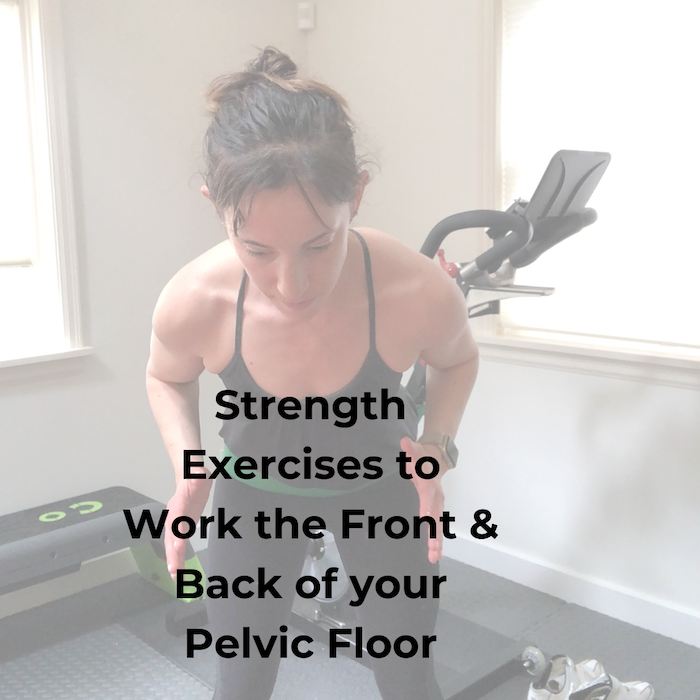Strength Exercises to Work the Front & Back of Your Pelvic Floor
How can you connect with the front & back half of your pelvic floor during a workout? Prior to having a baby I can't say I ever thought about the answer to this question. But, after several physical therapy sessions I realized I was better able to connect with one half of my pelvic floor vs. the other (not uncommon). I was experiencing stress urinary incontinence during activities or even while sneezing.
It took a lot of practice and patience, but learning different exercises and positions to help re (connect) with my pelvic floor was important for my postpartum recovery, and my athleticism and health long-term.
Step 1: Body Position / Alignment
Body positioning and alignment is one way we can set up our core system and body for success during a workout. The position we put our body in can enhance or diminish how available our muscles on our team are to support us, even before we move. What's the ideal position? A "neutral" position sets up our diaphragm and pelvic floor for success.

Neutral looks like ribs living on top of our pelvis, or essentially, diaphragm over our pelvic floor. The Transverse Abdominis helps maintain the relationship between these two structures, another reason connecting with and strengthening our deep core is important too.
Let's start with an alignment experiment.
Start in your neutral / natural posture - gently shift your weight back in your heels. In this position with your weight in your heels, perform a pelvic floor engagement. Close and lift Pelvic Floor up and in. Where do you feel the work?
Shift into a gentle diagonal forward leaning position. The movement should come from your ankles so your body stays put behind you (hold on to something as needed). Perform your pelvic floor contraction, closing and lifting your pelvic floor up and in. Where do you feel the work?
You may have noticed when leaning back into your heels you felt the contraction along the back half of your pelvic floor. Women are often more aware of activating on the backside of their pelvic floor around the anus versus the front side (Julie Wiebe) near the vaginal and urethral openings (where the pee exits). This is often when urine leaks are experienced. When leaning forward into your ski jump position you probably noticed you connected with more of the front side of your pelvic floor.
The goal:
Our overall goal is to get a more balanced contraction through the front and back half of our pelvic floor. Oftentimes women are instructed to kegel to "hold back urine" or "stop the passing of gas," but these cues only address the front or back half of the pelvic floor versus a more balanced engagement.
Many women who are struggling to stop urine leaks feel the contraction around the backside when they perform a kegel.
Exercises to Connect with the Front of your Pelvic Floor
Ski Jump position:
As described above, let's first start with the ski jump position to get comfortable. Shift your weight forward as if you were going to ski down a mountain. Your upper body and lower body should be aligned in a diagonal position with the shift occurring at your ankle.
Strength Exercises:
1. Ski Jump Squat
- Tie a thick resistance band around something sturdy. Step inside and take a few steps out so the band has some resistance pulling you back. Squat and fold back. Inhale on your way down and relax your pelvic floor, exhale and lean into the band as you rise, squeezing your glutes at the top and closing and lifting your pelvic floor up and in.
2. Ski Jump Deadlift:
Same set up. Add a weight at your feet. Hip hinge back, folding at your waist. Inhale on your way down, exhale to stand, drawing tummy up and in. The forward lean will force you to engage your glutes and the front side of your pelvic floor.
3. Banded Front Squat:
Take the resistance band and wrap it around something sturdy. Inhale as you lower into the squat, exhale, draw pelvic floor up and tummy in and up as you rise. Squeeze your glutes at the top. The point is to put the weight in your heels, so lean back slightly. The band will really give you the opportunity to lean into your heels and provide some of that support so you don't fall over :)
Ski Jump Squat + Deadlift (exercise link)
Give these two exercises a try and let me know what you think! I create customized programs for women in all stages of motherhood and 1:1 training. I'd love to support you :)
xoxo,
Erica

